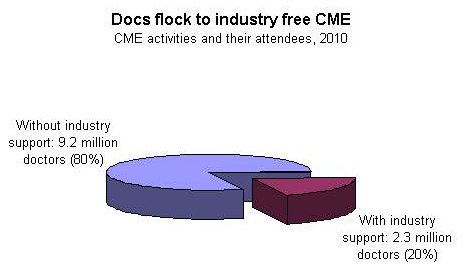Doctors are still getting their CME, but mostly the non-commercially supported kind.
Of the roughly 82,000 CME activities in 2010, most (80%) did not have commercial support, and these drew the most participants—about 80% of physician and non-physician participants, notes the Accreditation Council for CME (ACCME) in a just-released tally. The 20% that did receive such support attracted about 20% of participants.
As to what kinds of activities are the biggest draw, most doctors (67%) are flocking to grand rounds (27%) and internet enduring materials (40%). Courses drew only 13% of MDs, according to an addendum released Friday by ACCME.
The data, together with annual stats showing more doctors are paying their own way for CME, ease some fears that physicians’ access to education would erode along with commercial support.
Commercial dollars slid 31% since their peak in 2007, noted the council’s 2010 annual report, released last month. That year, the pharma and device industries kicked in $1.2 billion, or 48% of CME providers’ total revenue. Now it amounts to only $830 million, or 37% of the total.
To be sure, no one had expected doctors to stop attending CME events. Most need CME to keep licenses current and to maintain hospital admitting privileges. What had been feared is that quality and access would slide amidst industry’s pull-out.
But more doctors than ever are participating. In 2010 MD attendees rose to 11.4 million, a 6% increase from 2009. And more of them are chipping in. Registration fees, along with government and non-profit grants, represented 51% of CME providers’ income last year, or $1.1 billion, after a 9% surge vs. 2009.
What we still don’t know is the effect on quality, cautions the Association of Clinical Researchers and Educators (ACRE), a pro-industry group.
“When industry [funds] CME, it has the ability to bring in major, nationally known opinion leaders to a local event or a large regional or national event,” said Michael Weber, MD, professor of medicine at the State University of NY, Downstate College of Medicine.
Weber, who is also a member of ACRE, said attendees of commercially supported CME have the opportunity to hear from leaders in their fields, which plays a role in validating new research and medical breakthroughs.
“We may be losing that kind of activity, as industry reduces support,” he said.
On the provider side, CME has changed, too. Now the majority of industry grants are channeled to a small group of providers. ACCME said less than a quarter (22%) bring in more than $1 million per year in commercial support, with 2% bringing in $10 million or more.
As industry grants have dried up, many providers have exited the CME system. The ACCME lost 42 providers (6%) since 2007, including 13 (2%) between 2009 and 2010. Most of the loss has been from non-profit physician membership organizations, publishing/education companies and hospital/healthcare systems.
At the local level, 68 providers, mostly community hospitals accredited by their state medical societies, left last year, too.
Maryland has taken its share of those losses, but, “It does not appear to be a trend here, rather the outcome of some pretty difficult economic times,” said Frank Berry, the director of CME for the state’s medical society. He said that an economic recovery could stem the tide.








